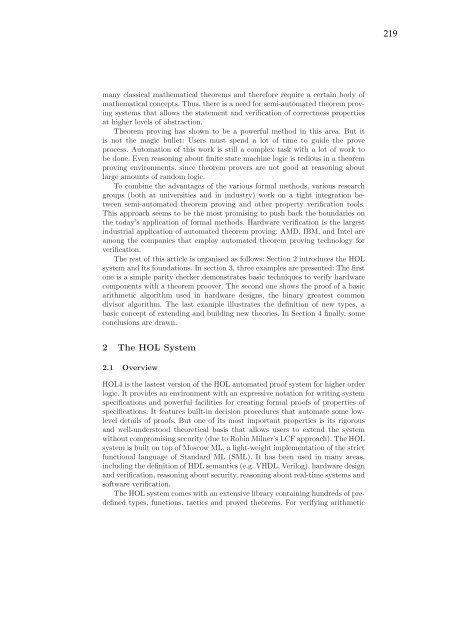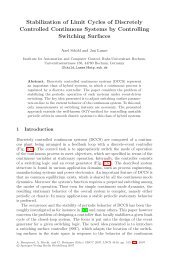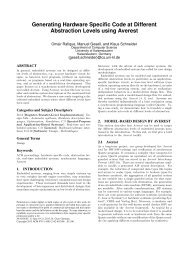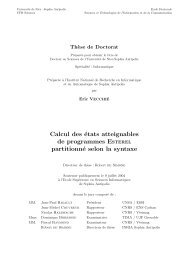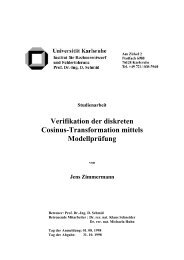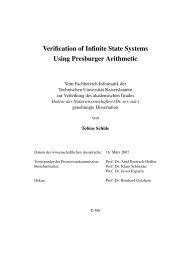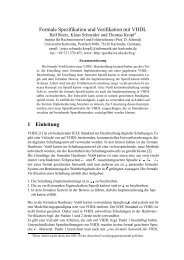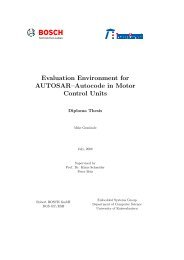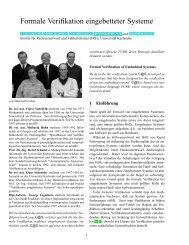Verifikation reaktiver Systeme - Universität Kaiserslautern
Verifikation reaktiver Systeme - Universität Kaiserslautern
Verifikation reaktiver Systeme - Universität Kaiserslautern
Erfolgreiche ePaper selbst erstellen
Machen Sie aus Ihren PDF Publikationen ein blätterbares Flipbook mit unserer einzigartigen Google optimierten e-Paper Software.
219<br />
many classical mathematical theorems and therefore require a certain body of<br />
mathematical concepts. Thus, there is a need for semi-automated theorem proving<br />
systems that allows the statement and verification of correctness properties<br />
at higher levels of abstraction.<br />
Theorem proving has shown to be a powerful method in this area. But it<br />
is not the magic bullet: Users must spend a lot of time to guide the prove<br />
process. Automation of this work is still a complex task with a lot of work to<br />
be done. Even reasoning about finite state machine logic is tedious in a theorem<br />
proving environments, since theorem provers are not good at reasoning about<br />
large amounts of random logic.<br />
To combine the advantages of the various formal methods, various research<br />
groups (both at universities and in industry) work on a tight integration between<br />
semi-automated theorem proving and other property verification tools.<br />
This approach seems to be the most promising to push back the boundaries on<br />
the today’s application of formal methods. Hardware verification is the largest<br />
industrial application of automated theorem proving: AMD, IBM, and Intel are<br />
among the companies that employ automated theorem proving technology for<br />
verification.<br />
The rest of this article is organised as follows: Section 2 introduces the HOL<br />
system and its foundations. In section 3, three examples are presented: The first<br />
one is a simple parity checker demonstrates basic techniques to verify hardware<br />
components with a theorem proover. The second one shows the proof of a basic<br />
arithmetic algorithm used in hardware designs, the binary greatest common<br />
divisor algorithm. The last example illustrates the definition of new types, a<br />
basic concept of extending and building new theories. In Section 4 finally, some<br />
conclusions are drawn.<br />
2 The HOL System<br />
2.1 Overview<br />
HOL4 is the lastest version of the HOL automated proof system for higher order<br />
logic. It provides an environment with an expressive notation for writing system<br />
specifications and powerful facilities for creating formal proofs of properties of<br />
specifications. It features built-in decision procedures that automate some lowlevel<br />
details of proofs. But one of its most important properties is its rigorous<br />
and well-understood theoretical basis that allows users to extend the system<br />
without compromising security (due to Robin Milner’s LCF approach). The HOL<br />
system is built on top of Moscow ML, a light-weight implementation of the strict<br />
functional language of Standard ML (SML). It has been used in many areas,<br />
including the definition of HDL semantics (e.g. VHDL, Verilog), hardware design<br />
and verification, reasoning about security, reasoning about real-time systems and<br />
software verification.<br />
The HOL system comes with an extensive library containing hundreds of predefined<br />
types, functions, tactics and proved theorems. For verifying arithmetic


